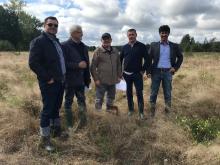Construction of a new SHP has started

Within a year, the Small Hydroelectric Power Plant will be built in Dobroszów Wielki on the Bóbr River, which will produce an estimated 6000 MWh per year. Works related to this investment started at the beginning of September. Contractors and investors met at the handover of the construction site
The scope of work includes the construction of a weir with a shell closure with a control room, construction of hydroelectric chambers, power plant building, inflow and outflow canal, protection of the bottom and slopes of the river, construction of an earth dike and steel wall on the left bank, and construction of a new fish pass for fish and stone rapids. A transformer station will also be built at SHP. The power plant will be equipped with automatic grate cleaners and, of course, turbo-generators.
An important issue that should be noted is the long-term cooperation of Wodel with the Gdańsk University of Technology, and now the Institute of Fluid-Flow Machinery of the Polish Academy of Sciences.